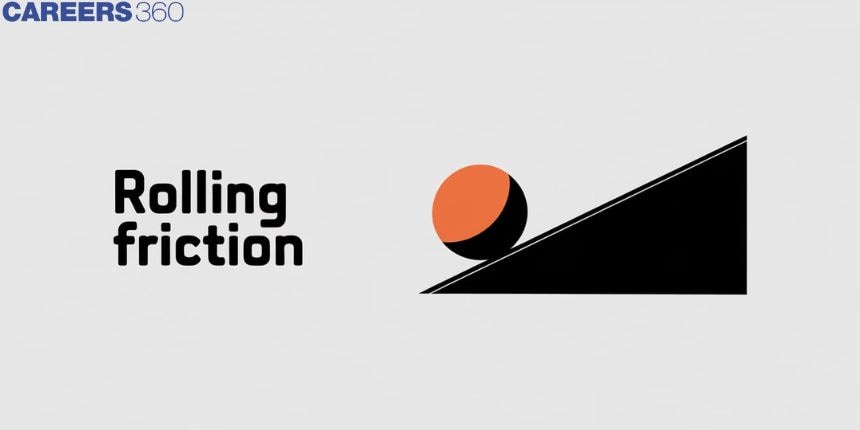Rolling Friction - Definition, Examples, Coefficient, Causes, FAQs
We all know that it is very difficult to pull a heavy almirah on a rough floor. But, if we attach four iron wheels to the bottom of that almirah, then it becomes much easier to push or even pull it. The iron wheel or any of those wheels do not slide on the floor. However, the wheels roll on the floor.
JEE Main/NEET 2027: Physics Important Formulas for Class 10
NEET 2025: Mock Test Series | Syllabus | High Scoring Topics | PYQs
JEE Main: Study Materials | High Scoring Topics | Preparation Guide
JEE Main: Syllabus | Sample Papers | Mock Tests | PYQs

This proves that the surface of the wheel which is in touch with the ground does not rub against the ground and hence doesn't slide on it.
The velocity of the given point of contact of the wheel in relation to the floor remains zero, and hence, the wheel keeps moving forward.
What is Rolling Friction?
"The forces that resists the motion of a rolling body on a surface is called rolling friction."
The rolling of a football, tennis ball, or even a wheel on the ground is an example of Rolling friction.
What is Sliding Friction?
In this type of friction, there are restrictions on the body’s movement as only one side of the body gets in contact with the surface.
Pushing a box is an example of sliding friction. Rolling friction is a little weaker than sliding friction.
It is usually not always necessary for a wheel or even a sphere will roll. It may also slide depending upon its motion, and also the forces acting on it. Sometimes, just to reduce energy losses due to friction, small steel balls are included in the rotating parts of the wheel machines that are known as the ball bearings.
Also read -
- NCERT Notes For All Subjects
- NCERT Solutions for All Subjects
- NCERT Exemplar Solutions for All Subjects
Laws of Rolling Friction
There are basically three laws of rolling friction:
- The force of rolling friction decreases with an increase in smoothness.
- Rolling friction is often expressed as a product of load and constant to the given fractional power. $\mathrm{F}=\mathrm{KLn}$
- Rolling friction force is inversely proportional to the radius of curvature and is directly proportional to load. $F=\mu \times W / r$
Causes of Rolling Friction
When given objects or substances are rolled onto a surface, certain things happen:
- The object is usually deformed at the point of contact with the present surface.
- The surface is usually deformed at the point of contact with the present object.
The motion is often created below the surface as a result of the above-mentioned two points.
The primary cause of this rolling friction is that the energy of deformation is usually greater than that of recovery energy. Also, an adhesive force exists between the two surfaces that need to be constantly overcome.
|
Related Topics |
Coefficient of Rolling Friction
Determination of the coefficient of this friction is usually more complex than that of sliding friction.
“Coefficient of Rolling Friction is the given ratio of the force of rolling friction to the total weight of that object.”
The coefficient of rolling resistance in empirical terms can be expressed as:
$$
\mathrm{Fr}=\mu \mathrm{r} \mathrm{~W}
$$
where,
- $\mathrm{Fr} \rightarrow$ resistive force of rolling resistance
- $\mu \mathrm{r} \rightarrow$ coefficient of rolling resistance
- $\mathrm{W} \rightarrow$ weight of the rolling body
Factors Affecting Rolling Friction
Following are some of the factors affecting rolling friction:
- The shape of the given wheel or the given curved surface
- Nature of the given surface on which the object is rolling
- Wheel speed
- Wheel radius
- The nature of the wheel material or even the curved surface
Examples of Rolling Friction
- A basketball that is rolled on the court will come to a halt due to its rolling friction.
- A bike that has broad tires will eventually burn more fuel as compared to others because of the increased rolling friction.
- A ball that is rolled on a field will go at a very lesser distance than that of a ball rolling on a concrete floor because it will eventually experience greater rolling friction on the former surface.
Difference between Rolling Friction and Sliding Friction
| Aspects | Rolling Friction | Sliding Friction |
| Definition | Resistance is when an object rolls over a surface. | Resistance is when an object slides over a surface. |
| Motion Type | Rolling motion (e.g., wheels, balls). | Sliding motion (e.g., dragging a box). |
| Friction Force | Lower than sliding friction. | Higher than rolling friction. |
| Surface Interaction | Less surface area in contact. | More surface area in contact. |
| Example | A car tire rolling on the road. | Pushing a heavy box across the floor. |
| Ease of Movement | Easier to move due to less resistance. | Harder to move due to more resistance. |
Frequently Asked Questions (FAQs)
The coefficient of rolling resistance in empirical terms can be expressed as:
Fr = μr W
The two types of friction are…
Rolling friction
Sliding friction
Pulling or pushing a box is an example of sliding friction.
Rolling a ball in circular motion on the ground is an example of rolling friction.
•The shape of the wheel or curved area.
•The nature of the rolling area.
•Wheel speed.
•Type of tire material or curved area.
Also Read
05 Feb'25 04:39 PM
25 Dec'24 10:26 AM
29 Nov'24 08:18 PM
29 Nov'24 11:02 AM
13 Nov'24 09:48 AM
12 Nov'24 11:22 PM
11 Nov'24 05:38 PM
11 Nov'24 11:37 AM
26 Sep'24 11:20 AM
26 Sep'24 11:12 AM